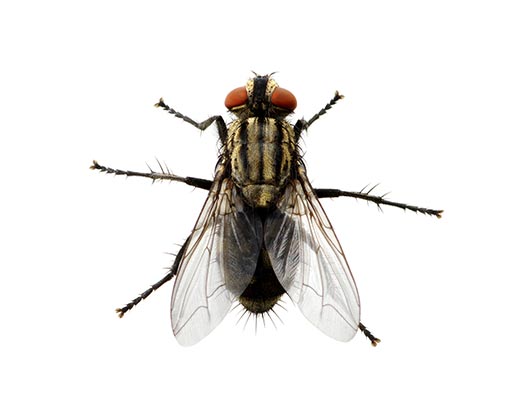HOUSE FLY
APPEARANCE
Usually grey, with four black stripes on their backs; less than 1/4-inch.
HABITAT
As their name implies, house flies are the most common type found in homes. They lay their eggs in almost any warm, moist material that will supply suitable food for the larvae. House flies excrete and regurgitate whenever they come to rest. This habit, combined with their many body hairs and the sticky pads on their legs, makes them well adapted for transporting disease organisms.
DIET
A wide variety of food, including human food, animal food and carcasses, garbage and excrement.
INSECT CONTROL: HOUSE FLIES
To minimize problems with flies, eliminate their breeding sites by throwing away trash in plastic bags. Let trash cans dry out, and keep them as far from your home as possible. Regularly pick up pet waste. For commercial establishments, professional cleaning of dumpers and nearby areas may be necessary.Equip all doors and windows with tight-fitting screens, and apply weather stripping to the edges of all doors and windows; flies can squeeze through amazingly small cracks.
FRUIT FLY
APPEARANCE
Tan brown with red eyes; 1/8-inch.
HABITAT
Fruit flies are attracted primarily to fresh fruits and vegetables, although any freshly decaying, moist organic matter will do. Once indoors, fruit flies can find and exploit other potential breeding sites such as poorly maintained trash containers, recycling bins, mop heads, garbage disposals, etc. They may also be found breeding in dumpsters outside and flying into the building through doorways. Because of their small size, many species are able to penetrate ordinary screens.
DIET
Ripened fruit or vegetables, or any other fermenting products.
INSECT CONTROL: FRUIT FLIES
The key to controlling fruit flies is finding the breeding sites and removing them by cleaning thoroughly. Some breeding sites will be obvious, like ripened fruit, while others, such a food kicked under a cabinet, may be easily overlooked. The inspection needs to focus on finding all sites where moist organic matter has accumulated and then removing that matter completely. Often in homes, fruit flies are carried in on bananas and when the bananas are removed, the presence of flies disappears within a few days.
DRAIN FLY
APPEARANCE
Hairy or fuzzy, resembling a tiny moth; black or brown. About 1/4-inch.
HABITAT
Drain flies breed in a heavily decaying organic matter that remains fairly wet. They are commonly found in sewage treatment facilities. In other commercial buildings, they are often seen in restrooms, mop closets and boiler rooms, breeding in drain traps, sump pumps, and any very wet, poorly maintained area. Drain flies are weak fliers and indoors are usually seen crawling on walls or other surfaces. When they do fly, it is usually only for a few feet and then in characteristic short, jerky lines.
DIET
A heavily decaying organic matter such as is found in sewage sludge is their preferred diet.
INSECT CONTROL: DRAIN FLIES
Finding the breeding sites and removing them is key to controlling drain flies. Inspection needs to focus on any place where wet organic matter has accumulated, including slimy drains, dirty garbage cans, bird baths or feeders, clogged roof gutters, moist compost and septic tanks. Clean drains regularly using appropriate.

